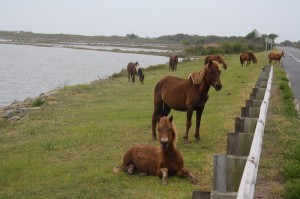
ASSATEAGUE — With Gov. Martin O’Malley this week introducing his latest attempt at offshore wind energy turbines off the Maryland’s Atlantic coast, it remains uncertain where the eventual transmission line will connect to the mainland, but it will not come across Assateague as was feared earlier.
Governor Martin O’Malley this week introduced his Maryland Offshore Wind Energy Act of 2013, perhaps moving a future offshore wind energy farm as close as 10 miles off the coast of Ocean City closer to reality. The long-range plan calls for an above-ground or underground transmission line coming ashore at some point and connecting the future wind energy turbines to an electric power distribution facility somewhere on the mainland.
Called the Atlantic Wind Connection (AWC), the network of underwater transmission lines would create a superhighway of sorts for moving the energy harnessed by future offshore wind farms to millions of electric service customers throughout the mid-Atlantic region. The AWC is currently exploring several options for a landfall for its transmission line along the Maryland coast including one proposal that had the line crossing Assateague.
Throughout the late summer and early fall, a coalition of local environmental groups including the Maryland Coastal Bays Program and the Assateague Coastal Trust, along with other private sector groups, quasi-governmental organizations and scored of environmental advocates and volunteers launched a grassroots effort and letter-writing campaign urging the federal Bureau of Ocean Energy Management (BOEM) to consider any and all alternatives to bringing the AWC ashore at Assateague and connecting it either above-ground or underground to a distribution facility inland.
Apparently the request did not fall on deaf ears as the legislation introduced by the governor on Tuesday includes specific language prohibiting a connection across or under Assateague.
“The Public Service Commission may not approve an application for a qualified submerged renewable energy line to be constructed or installed within the Assateague National Seashore Park or the Assateague State Park,” the bill’s language reads.
Maryland Coastal Bays Program Executive Director Dave Wilson said yesterday the MCBP and the coalition of environmental groups that fought against an Assateague landfall for the transmission were pleased their efforts were recognized in the proposed legislation.
“We’re glad to see that language in there,” he said. “We fought hard for that, as did a lot of other people. We had a lot of landowners on the west side of Assateague very concerned about a transmission line coming across to a destination further inland.”
Wilson said the coalition opposed any connection from the offshore wind to the mainland across Assateague and through the areas behind the barrier island, especially an above-ground connection. He said the already-developed areas to the north made more sense.
“An above-ground transmission line was always a non-starter for us,” he said. “The area south of Route 50 includes one of the largest and nicest areas of contiguous, protected natural resources we have. Areas north of Route 50 don’t have the pristine natural resources and are more developed already and might be more appropriate.”
For his part, Senator Jim Mathias (D-38) is a co-sponsor on the bill, but pushed for protections for Assateague and the coastal bays. Mathias said he had not reviewed every line of the legislation, but was confident the protections he pushed for in terms of Ocean City and Assateague are included in the bill.
“I have to go through the language carefully, but the protections appear to be in there,” he said. “I’ve spoken to the governor about our concerns for protections for Assateague and Worcester County and he was very responsive.”
